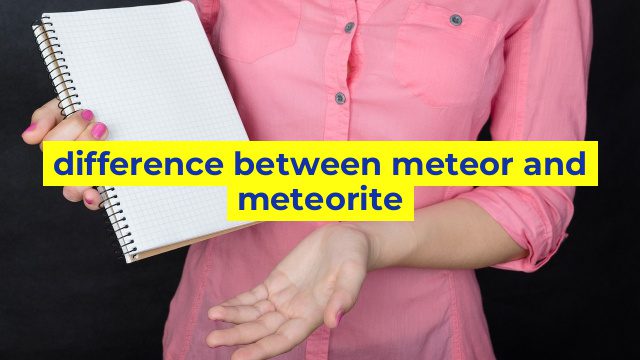Difference between Meteor and Meteorite – What You Need to Know
When it comes to outer space objects, many people often use the terms meteor and meteorite interchangeably. However, there is a notable difference between the two, and it’s essential to understand what each term means.
What is a Meteor?
A meteor is a space debris that enters the Earth’s atmosphere and burns up, creating a visible streak of light across the sky. Also known as a shooting star or falling star, meteors are commonly observed at night and usually last a few seconds.
Meteors are often made of fragments from asteroids or comets and can range from the size of a grain of sand to that of a basketball. They travel at high speeds, typically between 11 and 72 kilometers per second.
What is a Meteorite?
A meteorite is a space debris that makes it through the Earth’s atmosphere and lands on the ground. It originates from the asteroid belt located between Jupiter and Mars or from the remnants of comets.
Meteorites can vary in size, shape, and composition. They are categorized into three types: stony meteorites, iron meteorites, and stony-iron meteorites. Scientists study meteorites to gain insight into the formation and history of our solar system.
The Difference
The primary difference between a meteor and a meteorite is their location of origin. Meteors are space debris that is still in the atmosphere, while meteorites are debris that made it through and landed on Earth.
In terms of appearance, meteors present as a bright streak of light, while meteorites may have a crusty or pitted surface resulting from the intense heat they endure as they enter the Earth’s atmosphere.
Final Thoughts
Understanding the difference between a meteor and meteorite is crucial in appreciating the wonders of the arctic space. While the two terms may seem similar, their characteristics, formation, and impact are significantly different. Knowing their differences can help explain the fascinating phenomena that occur in our skies and the secrets that meteorites hold.
Table difference between meteor and meteorite
| Feature | Meteor | Meteorite |
|---|---|---|
| Origin | Comes from space and enters Earth’s atmosphere | Comes from space, enters Earth’s atmosphere, and lands on the Earth’s surface |
| Appearance | Often seen as a shooting star or fireball in the sky | Can range in size from small pebbles to large boulders and often have a fusion crust or regmaglypts |
| Composition | Mostly made up of rock, metal, and dust particles | Mostly made up of rock and metal, and may have different types of inclusions such as iron-nickel minerals, silicates, or diamonds |
| Impact | Does not reach the Earth’s surface, usually burns up in the atmosphere | Can leave impact craters or cause damage to buildings or other structures upon impact |

